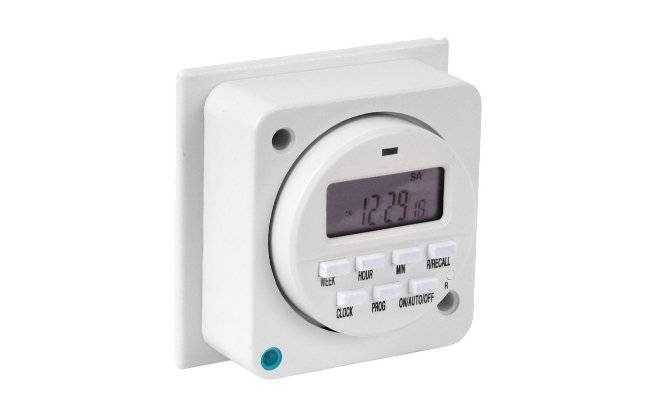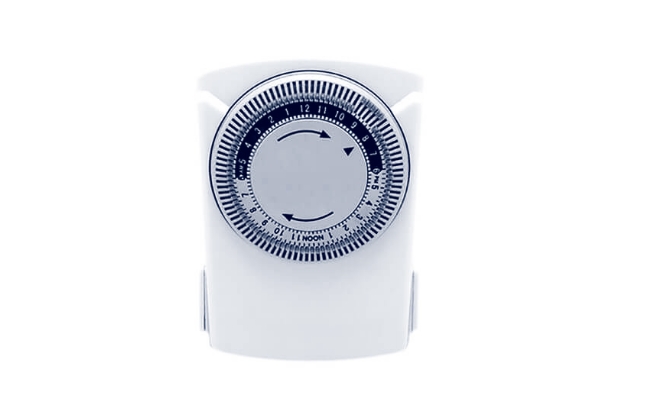How to Program Your Light Timer: 2024 Ultimate Guide

Light timers are incredibly handy devices that allow you to automate your lighting, providing convenience, security, and energy savings. Whether you're planning to simulate your presence when you're away, manage your outdoor lighting, or save on electricity bills, programming a light timer is a straightforward process that anyone can master.
In this step-by-step guide, we'll walk you through the process of programming your light timer. Keep reading!
Please check out our comprehensive guide on how to burglar proof your home if you are interested in learning more about them.
Different Types of Light Timers
Before we know the setup details, it's essential to understand the various types of light timers available to ensure you select the right one for your specific needs.
Mechanical light timers
A mechanical light timer is a device used to control the timing of electrical lighting systems. These timers function without the need for electricity or batteries, relying on mechanical components, typically springs and gears, to measure and regulate the passage of time. A mechanical light timer.
Mechanical light timers are commonly used for various applications, including controlling indoor and outdoor lighting. One classic example of a mechanical light timer is a manual twist timer switch that you can set to turn lights on or off after a predetermined duration.

Digital light timers
Digital light timers are advanced devices designed to control the timing of electrical lighting systems with precision and programmability. Unlike mechanical timers that use springs and gears, digital light timers employ electronic components and microprocessors to manage and automate lighting schedules.
Digital light timers offer precise control, allowing users to set specific on/off times down to the minute. They provide exceptional programmability, enabling the scheduling of multiple cycles daily or weekly, making them versatile for applications like simulating occupancy, conserving energy, and boosting security. Most digital timers feature a user-friendly LCD or LED display for effortless monitoring and adjustment of settings.
Smart light timers
Smart light timers offer convenient and versatile lighting control. Users can remotely manage their lights through smartphone apps from anywhere, making on-the-fly adjustments easy, even when away from home. These timers often integrate with voice assistants ( such as Alexa, Google Assistant, or Siri.), allowing voice commands for hands-free control.
Customizable schedules provide precise control for energy conservation, security, and convenience, while seamless integration into smart home ecosystems automates lighting in sync with other devices. Real-time remote monitoring and energy-saving features like dimming and color temperature control further enhance efficient lighting management.
How to Set Light Timer for Outdoor/Indoor Lights?
Setting a light timer for outdoor or indoor lights is a straightforward process that can help you automate your lighting and enhance both security and convenience. In the following steps, we'll outline how to configure your light timer for optimal control of your lighting systems, whether indoors or outdoors.
How to set the mechanical light timer?
- Mechanical light timers typically feature a numbered dial on their front face. To set the timer accurately, use your fingers to grasp the outer ring of this dial and rotate it clockwise until the arrow on the inner circle of the timer aligns with the current time.
- Press the button next to the hour and fraction of the hour at which you want the light to turn on. For example, if you want it to activate at 5:30 PM, press the button that falls between the 5:00 PM and 6:00 PM positions.
- Depress all the consecutive buttons on the timer, aligning them with the time at which you want the light to deactivate. Each of these buttons corresponds to the duration for which the light will stay on. For instance, if you desire the light to activate at 7:00 PM and deactivate at 5:00 AM, press down all the buttons between the 7:00 PM marker on the dial and the 5:00 AM marker on the dial.
- Activate the timer by toggling the power switch located on the timer's side to either the ON or AUTO setting, often indicated by a clock symbol. Then, insert the timer into an available wall outlet at the location where you intend to connect a light.
- Insert the power cable of your desired light fixture into the timer and switch on the light. Attach a lamp or any other light source you wish to control according to the scheduled times to the electrical socket on the timer.
How to program a digital light time?
- Hold down the "CLOCK" button and use the "HOUR," "MIN," and "WEEK" buttons to adjust the current day and time displayed on the digital screen. Release the "CLOCK" button once you've finished making the changes.
- Press "PROG" to set the activation time using the "HOUR" and "MIN" buttons, and choose the days of the week with the "WEEK" button. Then tap "PROG" again to configure the turn-off time using the same buttons and select the days. To return to the main display, press the "CLOCK" button once you've finished these settings.
- By default, the display indicates that the timer is in the "OFF" mode, meaning it won't supply power to your light. To enable the timer to control your light based on the schedule you've set, press the "ON/AUTO/OFF" button until the display changes to "AUTO."
- Finally, Insert the programmed timer into an available electrical socket. Then, plug the power cord from your lamp or other light fixture into one of the timer's outlets. Make sure to switch on the light's power, allowing the timer to control it based on your programmed schedule.
How to set smart light timers?
Setting up smart light timers involves using a smartphone app or a voice-controlled assistant like Amazon Alexa or Google Assistant to create schedules for your smart lights. It is the easiest to set a smart light timer.
- Look for options in the app to create a new routine, schedule, or timer. This may be called "Automation," "Scenes," "Schedules," or something similar.
- Select the smart lights or plugs you want to control with the timer.
- Specify when you want the lights to turn on and off. You can usually set different schedules for different days of the week.
- Some apps offer advanced settings, such as adjusting brightness, color, or color temperature at different times. Finally, save the timer or routine, and enable it.
How to Use Light Timers for Security?
Set timers strategically
Create a Schedule: Set your timers to turn lights on and off at different times of the day to mimic the natural lighting patterns in your home. For example, have lights turned on in the evening and off late at night.
Vary the Schedule: If you have multiple timers, stagger the on and off times of different lights to give the appearance of activity in different areas of your home.
Use multiple timers
Don't limit yourself to a single light timer. Use multiple timers for different rooms and lights, especially on different floors of your home. This creates the illusion of activity throughout the house.
In addition to traditional indoor light timers, use outdoor timers for porch or garden lights. These timers can create the illusion of someone entering or exiting the house.
Utilize smart home integration
If you have a smart home system, you can program your lights using your smartphone or voice commands. Smart lighting systems offer more control and customization options.
What are the Benefits of Using a Light Timer Switch?
Using a light timer switch has many advantages that can significantly impact your daily life and the efficiency of your lighting systems. The following are benefits.
-
Energy savings: Light timer switches allow you to schedule when your lights turn on and off. This helps reduce energy consumption by ensuring that lights are only on when needed. You can avoid leaving lights on all day or overnight when they are not required.
-
Remote control: Some light timer switches are compatible with smartphone apps or smart home systems, enabling remote control and monitoring of your lighting schedule or motion sensor lights, even when you're not at home.
-
Customization: Many light timer switches offer customizable programming options, allowing you to set different schedules for different rooms or days of the week. This flexibility accommodates your specific lighting needs and preferences.
-
Security enhancement: Light timer switches can enhance home security by creating the appearance of an occupied home, even when you're away. You can set your lights to turn on and off at specific times, deterring potential burglars who may think someone is inside.
-
Cost savings: Reduced energy consumption and extended bulb life can lead to cost savings on electricity bills and replacement bulbs over time.
FAQs
1. How Does a Light Timer Work?
A light timer is essentially an electrical circuit with an integrated clock mechanism. It's designed to enable users to set specific times for turning their lighting on or off to suit their individual needs. When it comes to purchasing options, there's a range of choices available, including devices with single or multiple electrical outlets and some that are integrated into comprehensive security systems. These timers come in various types, with mechanical and digital versions being the most common.
Digital timer switches are typically connected to the main electrical supply. They incorporate timing circuitry and switching components, notably lacking any moving parts. Users can program these switches to activate or deactivate lights at designated times. Additionally, some of these switches offer advanced features, such as the ability to preset lighting levels and create recurring lighting schedules.
2. How do I choose the right light timer for my needs?
To select the right light timer, first, determine your purpose (security, energy savings, etc.). Consider the type of lighting and indoor/outdoor use, then decide between mechanical or digital timers based on programming needs. Look for features like randomization, smart home compatibility, and budget considerations. Read user reviews, check for warranties, and make an informed choice that suits your lighting control goals.
3. What if I want to override the timer and turn the lights on or off manually?
Most timers have a manual override option. Simply switch the lights on or off manually, and the timer will resume its programmed schedule during the next cycle.
Conclusion
Programming a light timer is a simple yet effective way to enhance your home's security, convenience, and energy efficiency. Light timers offer a versatile solution, whether you're looking to create the illusion of an occupied home when you're away, optimize your lighting for energy savings, or automate your daily routines.
If you like this article and find it helpful, share it with your friends. Got something to say about the light timer? Make sure you leave a comment below!
Search
Be in the Know
Security insights & offers right into your inbox
